#resident representative nicola
Text
Toxic Waters Lite: Health and Ammo
The issue of retro games being notably "retro" usually comes down to a particular health system, or their healing in general. For example (and totally paraphrasing from my games design class) Mario has the mushrooms which make you larger, effectively an extra life, while Sonic has collectible rings that work as a health system - when you die, you lose them all. My game has a gun as a key gameplay mechanic, but I won't include reloading. While it can add tension to a situation, forcing you to become defenseless for a small period, the level's limited ammo already enforces this feeling. Plus, most retro games don't have reloading, especially side-scrollers. I believe the first game to have reloading was Marathon, one of my favorite games, but I am definitely digressing. Anyway, health. My plan is for you to have three hit points, and then you're dead. In the vein of Resident Evil (vein, infection jokes, geddit?) I plan for a sort of vitals tracker in the corner of the screen, to show your health. Making a full-on heartbeat monitor will require animation, something I don't want to waste precious dev time on. Instead, I will add a fake LED display, as if it is reading off Nicolas' suit, a la Dead Space. His statuses of "Fine", "Wounded" and "Severe" will be represented by various colors of smiley face, and a circular health readout surrounding the icon. Alternatively, I might give it a striped design reminiscent of an inflatable life preserver. This works for a few reasons; (1) it fits with the orange-yellow aesthetic of Toxic Waters Lite, (2) it makes sense for a health bar, and (3) it works for a water setting.
3 notes
·
View notes
Text
She "does nothing that is not delightful": Marquise Du Parc.
The next candidate for stardom was also a widow, although somewhat merrier. Marquise-Thérèse Gorla, known as Mlle Du Parc, was the opposite of Mlle Des Œillets: she was a less accomplished actress, but beautiful and notorious because of her relationship with Racine. References to her by the gazetteers almost always stress her height and her beauty and her ability as a dancer; she was the grande et belle Mlle Du Parc. Recent scholarship has also made much of her. For instance, in his earliest account of seventeenth-century actors, Les Grands Comédiens du XVIIe siècle, Georges Mongrédien includes biographies of nine actors and one actress: Marquise Du Parc.
[..]
The glimpses we get of Mlle Du Parc over the next few years all testify to her attractiveness to men. When Daniel de Cosnac, for isntance, describes the competition between the Molière-Béjart troupe and the troupe of Cormier to become the prince de Conti's resident company in Pézenas in 1653, he notes that the prince's secretary, Sarasin, favored the Molière-Béjart troupe because he had fallen in love with Mlle Du Parc. And both Pierre Corneille and his younger brother Thomas wrote love poetry to her, although, as Georges Forestier notes, it would be injudicious to assume, as some have, that they were in love with her. To do so would be to
"ignore all the poetic tradition: for Corneille, Marquise was the pretext for a long-distance joust with the great Ronsard on the theme of fugitive beauty and immortality, of the revenge of the aging poet… Thomas Corneille also wrote some verses to her, as if the two brothers were engaged in a little poetic tournament with Marquise as their inspiration."
Molière wrote a verse to her as well, very conventional, remarking on her beautiful complexion, her admirable figure, even her wit. Part of the Molière roman is the belief that he was in love with her or slept with all three of the actresses in the provincial troupe: Madeleine, Marquise, and Catherine de Brie. In fact, there is no hard evidence that he was the lover of either Mlle de Brie or Mlle Du Parc, both of whom appear to have been content with their husbands. André Chagny, in his biography of Mlle Du Parc, concludes that her private life was perfectly correct until after her husband died. And, besides, she was very often pregnant. She had at least five children, three of whom were living at the time of Du Parc's death in 1664.

Sorting out what roles Molière may have written for Mlle Du Parc is not easy, but it does not appear that he featured her or thought of her as a star. We are reasonably sure that none of his major ingenue roles were written for her; those usually went to Mlle de Brie and, later, to Mlle Molière [..]
It was when Molière introduced his comedy-ballets that someone like Marquise Du Parc would have been invaluable. The first of these plays with music was Les Fâcheux, written for Nicolas Fouquet's ill-fated fête at Vaux-le-Vicomte on August 17, 1661 [..] However, even though ballet interludes were normally performed by hired professionals and not by members of the troupe, in this instance Loret writes about:
La Du Parc, that beautiful actress,
With the bearing of an Empress,
Who, whether singing or dancing,
Does nothing that is not delightful.
[..]
Molière found other opportunities to capitalize on the legs, the beauty and the presence of Mlle Du Parc, especially during the famous Plaisirs de L'Ile Enchantée, Louis XIV's 1664 entertainement at Versailles. On the first day she represented "Spring", dressed in green embroidered with silver and multi-colored flowers, and spoke a tribute to the queen Marie-Thérèse..
Virginia Scott- Women on the Stage in Early Modern France: 1540-1750.
#xvii#virginia scott#women on the stage in early modern france#marquise du parc#mademoiselle du parc#actresses#jean baptiste poquelin#molière#nicolas fouquet#louis xiv#marie thérèse d'autriche
8 notes
·
View notes
Text







“So that everything fits and the plot has drive...” (a commentary on Case for a Rookie, a work by Jan Lesák).
Although I would prefer not to stir the melting pot of opinions attempting to overcome modernism, I should mention the following association. Jan Lesák’s work Case for a Rookie, based on a transcript of Pavel Juráček’s movie Case for a Rookie Hangman, somehow evokes within me Petra Herotová and the thoughts associated with her sculpture called Spinning (2007), which she created by piling ‘identical’ drawings on top of each other with a view of them being used in animation.
That which during the time of tense individualistic conquering of unknown territories and forms would have created discomfort and appeared immoral presents today a desired moment of connection within a wide array of opinions. Both works are similar in form, however, particular aspects of the works are in divergence. Firstly, although both works, in their aim for a cohesive whole, bring together the mediums of film and sculpture (in the case of Lesák, object), Lesák’s Case for a Rookie is based on a film while Herotová’s Spinning is aimed at animation. The repetition of a drawing a thousand times (its nuances being important in creating animated movement) and the placement of the individual drawings one upon the other allow for the creation of a sculpture. On the contrary, Jan Lesák emphasizes continuity. The text flows continuously from page to page; the pages are in regular A4 format. Photographical display of the film Case for a Rookie Hangman present in the object (photographical documentation of one film segment represented by a typewriter text line on an A4 format) is the only moment that freezes the flow. This showcase of inner content makes time stand still and together with a red bookmark makes the photo a motionless object with its own time and space.
This rather uncomplicated work by Lesák can be interpreted from several theoretical viewpoints – the loss of aura in an artistic object (Walter Benjamin), relative aesthetics and postproduction (Nicolas Bourriaud), and the practice of ‘re-enactment’ and psychoanalysis. It connects two seemingly contradictory methods – the empathic and mechanical. It may be this connection that partially shows the Kafka-like absurdity emanating from Pavel Juráček’s films: 1) the mechanical process of transcribing spoken word, 2) the pragmatic senselessness of this activity, 3) the determination of the work’s physical form by the material and equipment (A4 paper, typewriter) used, 4) the placement of film content in the middle of the work is in strained contrast to experiencing the film through writing, which emphasizes active and creative perception and allows infinite avenues of interpretation.
However distant the author’s chosen form is, surrealist flashes of the original film break through the sterile, office-like, minimalist and conceptual aesthetics. It may also be the result of an invisible mark left by an almost month-long mental residence of a scribe within the author. The new work is in conflict with the original film (1969) and even if the viewer is not familiar with the original film, after reading several lines of the new work, he/she quickly becomes infected with its associative images. The mechanical process described above is actually the first sign of insanity (the artist refers to the character of Jack Torrance in The Shining, or rather the endless pages of manuscript he types up with the same sentence) as well as insurmountable absurdity which leads to it.
The projection of the film is the last component of the whole installation – it is like a wall painting which, as it were, only echoes the physical shape of the work (the pile of papers). The content is halved and it is in black and white.
And so now I would like to end this commentary by quoting the last line of a thesis appraisal by Jiří Kovanda, “What does the black line (note by E.J.: surface) that cuts through the white block mean? Mercilessly, right through the middle...“
Aby všechno sedělo a děj měl spád (Poznámka k dílu Jana Lesáka Případ pro začátečníka)
Aniž bych chtěla přihřívat v dnešní situaci už tak rozvařenou polévku překoná(vá)ní moderny, poznamenám následující návaznost. Práce Případ pro začátečníka Jana Lesáka, jejímž základem je přepis filmu Pavla Juráčka Případ pro začínajícího kata do textové podoby, mi nedá nespojit Lesákovy myšlenky s o něco staršími myšlenkami Petry Herotové a její sochy, tvořené na sebe vršenými „identickými“ kresbami s potencí k animaci Spinning (2007).
To, co by v době vypjatých individualistických dobývání nepoznaných sfér a forem vadilo a bylo nemorální, dnes představuje chtěný moment propojení v rámci širokého názorového pole. Obě práce jsou si velmi podobné formálně, nicméně jednotlivé aspekty se rozbíhají jinam. Předně, přestože obě propojují ve svém směřování k většímu celku médium filmu a sochy (u Lesáka objektu), Lesákův Případ z filmu vychází, Herotové Spinning k animaci cílí. Tisícenásobná repetice té samé kresby (byť její nuance jsou důležité pro možnost animačního pohybu) vytváří u Petry Herotové aditivně z jednotlivých řezů (kreseb) celek sochy. Jan Lesák naopak zdůrazňuje plynulost. Text přetéká v regulované krajině A - čtyřkového formátu ze strany na stranu. Fotografická prezentace přítomnosti filmu v objektu (fotodokumentace jedné části textu filmové úsečky, mechanicky vymezené vztahem fontu psacího stroje a formátu A4) je oním momentem, který zmrazuje tento tok. Toto názorné předvádění vnitřního obsahu zastavuje čas a dělá na fotce z filmu nehybný objekt, kterému navíc indikací červené záložky podsouvá nejen vlastní čas, ale i místo.
Na toto vcelku jednoduché dílo Jana Lesáka se dá uplatnit hned několik teoretických postulátů od ztráty aury uměleckého díla Waltera Benjamina, vztahové estetiky a postprodukce Nicolase Bourriauda až po praktiky „re-enactmentu“ a psychoanalýzy. Spojuje v sobě dvě zdánlivě protichůdné metody - empatickou a mechanickou. Možná právě toto spojení v díle zlomkovitě zachycuje něco z kafkovské absurdity filmů Pavla Juráčka. 1/ mechaničnost vykonávání přepisu mluveného slova, 2/ pragmatická nesmyslnost takové činnosti, 3/ fyzická determinace formy díla na použitých materiálech (A4, psací stroj), 4/ umístění obsahu filmu přesně doprostřed formátu strany jsou v napjatém vztahu k jinakosti čtení filmu skrze psaní, které zdůrazňuje aktivní a tvořivou povahu percepce a nesmrtelnost díla v interpretační nekonečnosti.
Jakkoliv distanční formu autor zvolil, skrze sterilitu vyprázdněné kancelářské, minimalistické a konceptuální estetiky se prodírají surrealistické záblesky původního filmu. Je to možná také důsledek neviditelné stopy, kterou v díle zanechala autorova skoro měsíční mentální rezidence skriptora v něm. Starý film (1969) napadá nové dílo a pokud jej divák nezná, i skrze několik prezentovaných řádků jej napadá jeho nakažlivá asociativní imaginace. Výše zmíněná mechaničnost je nakonec průvodním jevem šílenství (autor připomíná postavu či spíše hromadu papírů popsaných stejnou větou spisovatele Jacka Torrance z filmu Shinning) tak jako bezvýchodná absurdita, která k němu vede.
Zástupnou projekcí filmu je poslední komponent celkové instalace - nástěnná malba, která jakoby pouze schematicky opakovala obvod díla (sloupce papírů) rozpůleného obsahem, černým na bílým.
A abych v duchu neoriginality ukončila tuto poznámku k dílu Jana Lesáka stejně jako Jiří Kovanda, cituji z posudku vedoucího diplomové práce jeho poslední větu: „Co tedy znamená ta černá linie (poznámka E. J.: plocha) protínající bílý kvádr? Nelítostně a právě uprostřed...“
Edith Jeřábková, 2011
0 notes
Text
200 leading French called for a march against immigration law
Some 200 leading French figures – actors, writers, journalists and trade union representatives – called for demonstrations on 21 January against the immigration law, calling it “a dangerous turning point for the Republic” in an article published on 7 January in the newspaper L’Humanité.
In a text published by daily L’Humanité and online publication Mediapart, 200 leading figures denounced the immigration law and called for demonstrations on 21 January. Among the signatories are actresses Josiane Balasco and Julie Gayet, writers Nicolas Mathieu and Alice Zeniter, and trade unionists Marilise Leon (CFDT) and Sophie Binet (CGT).
The law, passed at the end of December and supported by the LR and RN parties, restricts social benefits for foreigners, introduces migration quotas, questions the automatic nature of the right to legal residence and reinstates the “offence of illegal residence”. It also gives prefects discretionary powers to regularise the status of illegal workers in so-called “short-staffed” professions.
President Emmanuel Macron defended it, noting it was a “shield that we need” in France.
Read more HERE

#world news#world politics#news#europe#european news#european union#eu politics#eu news#france news#france#french news#french politics#emmanuel macron#migration#migrants#asylum seekers#immigrants#immigration#immigrant rights
0 notes
Text
The Never Changing Nature of Humanity and War
As another year ends, I look back over the major events that defined it and despair. Humanity seems desperate to repeat the same mistakes of old. Though there are moments when we shine, we are still motivated by greed, jealousy and pride. Look no further than the two wars currently being fought, the posturing in the Pacific and how little our world has done to combat climate change. Still, I suppose things could be worse. We might, after all, be suffering the effects of a nuclear winter (except no-one yet has the cajones to start such a huge chain reaction just yet).
But I digress.
January 2023 was a mess of events. Here in Australia, news of Pope Benedict passing away was only in headlines on New Year's Day. Other notable deaths included George Pell (a cardinal who was sent to prison for child sexual abuse in 2019 but who had his convictions later quashed) and the former king of Greece. From there, the world spiralled with Europe enduring very warm temperatures for winter (turns out 2023 was the hottest year on record!), Jacinda Ardern resigned from being Prime Minister of New Zealand/ Aotearoa. In Brazil, Bolsonaro tried to pull a Trump by stoking a Capitol-riot-style insurrection. This was later met be counter protesters.
As the year progressed, Kevin McCarthy was elected as speaker to the House of Representatives after going through fifteen rounds of voting. He was later removed and later replaced by another Republican: Mike Johnson. News of his Kevin McCarthy's unsuccessful bids were later drowned out by the shooting down of a Chinese air balloon. This led to several other unidentified objects to be shot down, which later turned out to be weather balloons set up by civilian scientists.
The United Kingdom enjoyed protests and strikes among public servants due to rising costs of living. Madrid protested their leftist government. Nicola Sturgeon, Scotland's First Minister, resigned.
But in case the first quarter of the year wasn't exciting enough, Mother Nature also wanted to have a little fun by sending a cyclone towards New Zealand (Aotearoa), with many residents suffering from flash-flooding. Oh, and there was an earthquake too!
An earthquake also hammered Turkiye and Syria. What's particularly telling, though, was the fact most of the humanitarian aid was directed to and more focused on the citizens of Turkiye rather than Syria. It lefts thousands dead and millions were displaced. Thankfully, though, it didn't much impact this blogger's trip overseas as our tour stayed primarily in the western portion of Turkiye and din't venture too far south.
From there, we saw the rise of the H5N1 avian flu, killing huge swathes of domestic and wild birds. The flu also had outbreaks in mink farms. So, although COVID-19 might be in the rearview mirror, there are plenty of new diseases ready to take its place! Like the zombie dear disease which as been spreading in Yellowstone! Essnetially, though, it's a chronic wasting disease with symptoms such as drastic weight loss, stumbling, listlessness and other neurological symptoms. While there are no current reported cases of this in humans, studies suggest it could pose a risk to anyone who eats meat from infected animals.
Of course, one should never forget that COVID-19 is still rampant around the world. We've all just comfortably shoved the little inconvenience to the back of our mind, even as it features as one of the core reasons for death.
Back home in Australia, permanent residency was being offered to many refugees who held temporary protection visas. There was also a resumption of assessments for asylum seeker sponsored visas where they would try to bring family members over.
Speaking of refugees (and jumping ahead a few months), there was a shipwreck off Greece carrying several hundred refugees and migrants. Most were fleeing conflicts in their countries. Of major note was the one in Sudan between the army and a paramilitary force. And when you have many countries refusing to take up migrants or helping out their fellow humans (looking at Tunisia cracking down on illegal immigrants), you end up with many a humanitarian crisis.
Further disasters abounded with a head-on crash in Greece leading to 57 being killed. China later had its own subway crash due to heavy snowfall causing carriages to detach. India, too, also had a train crash killing about 100 people.
Elsewhere, many other social media services began to emulate Elon Musk's subscription services for Twitter X, allowing users to become 'verified.' The Silicon Valley bank collapsed, followed by Credit Suisse leading to a significant downturn on Wall Street as people panicked.
In happy news, Everything Everywhere All At Once won 7 Oscars. A victory, it seemed for so many people living in Asian diasporas across the Western world. Given that many Asians were attacked during the COVID-19 pandemic simply because of their appearance, the win of Everything Everywhere All At Once proved to be a pivotal moment for many.
As the year rolled on, the International Criminal Court issued out a arrest warrant for Vladimir Putin. Trump was indicted for falsifying business records. He was even later arrested. But alas, nothing has seemed to stick and Trump has used many of the court cases brought against him to target those who would stand against him in his bid for the 2024 electoral campaign.
Following the death of Her Royal Majesty, Queen Elizabeth II last year, King Charles III enjoyed a state coronation alongside his wife, Queen Camilla.
Other quick events: Joe Biden was forced to cancel a trip to Australia to deal with the US debt ceiling. There was the discovery of a Kenyan starvation cult. Tina Turner passed away. There was the destruction of a dam in southern Ukraine by Russian forces.
And in the news of cyber security, there was a hack of file-transfer program MoveIt, affecting many companies and governments. This was topped by a hack against Insomniac and the leaking of 1.6 TB of files showing games in development as well as the personal information of many employees.
As the northern hemisphere reached the summer, Canadia endured several severe wildfires that even affected the air quality in America. Silvio Berlusconi passed away and to cap it all off: five people were killed in an imploding submersible headed down towards the Titanic.
In other news, both domestic and international, corruption findings were noted of previous New South Wales premier, Gladys Berejiklian. A teenage boy was shot dead in France leading to protests. Microsoft won a case against the FTC to delay a merge with Activision-Blizzard. SAF-AFRA began to strike alongside the writer's guild regarding working conditions with the move to streaming and the threat of AI supplanting jobs.
With summer peaking and then waning, heatwaves continued to devastate America, Europe and Asia. There was the passing of a controversial bill in Israel limiting the power of the Supreme Court to overturn decisions made by government ministers. In Niger, the military staged a coup.
To put our thoughts at ease, people turned on their televisions and headed to stadiums to watch the FIFA Women's World Cup hosted by Australia and New Zealand. Although Spain won, I'm happy to say Australia's own team came in fourth with a strong showing and with much love showered on our Matildas.
To keep us on our toes, however, we also saw the death of Wagner Group leader in a plane crash: Yevgeny Prigozhin. There was chaos in New York when live-streamer Kai Cenat decided to host a Give Away event. In Africa, there was another coup. This time in Gabon. And in some positive news, India was the first country to land on the Moon's south pole.
As the rest of the world headed towards winter, and Australia to summer, Mother Nature thought another earthquake would shake things up a little - killing thousands in Morocco. There was also an earthquake in Afghanistan, killing quite a number of citizens.
And just to fill out our assassination quota for the year, Sikh separatist leader Hardeep Singh Nijjar was killed in Canada.
But in a move to surprise us all, and to raise the stakes in our very fragile ecosystem, Hamas launched an attack on Israel on 7 October, killing a few thousand and taking hundreds hostage. Israel, of course, retaliated - vowing to crush Hamas. This has since led to Israel bombing the Gaza strip, killing many hundreds of people including children and a few of their own people in a desperate bid to stamp out Hamas.
While there was a brief ceasefire and a release of hostages, the situation is still quite dire for many Palestinians. And now Iran has taken a step, declaring they would close off the Mediterranean.
In Australia, we hosted a referendum for the Voice to Parliament. Unfortunately, it was a campaign filled with a lot of disinformation and misinformation. To my dismay, the Voice to Parliament failed, setting Australia back when it comes to acknowledging Indigenous voices.
As for those clamouring for a Treaty first, while I agree with you that a Treaty would be important, a Voice would have greatly paved the way. Even if it might not have been an immediate change or be the change everyone wanted, sometimes the best way to make things better is by taking small steps. True, it might not be what one hopes for but when it comes to swaying the minds of the public on key issues, governing a nation is a delicate balancing act. TAKE WHAT YOU CAN GET BUT DO NOT TRY TO HOLD THE PEOPLE/ BUDGET HOSTAGE. Public opinion IS important but relying solely on populism will get you nowhere and a country in shambles.
Australia also saw several bushfires in Queensland and norther New South Wales. We even had an Optus outage nation-wide, where many people had no internet or phone coverage. It proved, once again, the disadvantages of relying solely on technology and our phones for anything and everything.
And as we neared closer to Christmas and the New Year, Henry Kissinger passed away at the age of 100. In China, there were reports of another mysterious respiratory disease affecting children - with cases of pneumonia beginning to spike again. In north-east Myanmar, a temporary ceasefire was negotiated between the rebels and the military government. New Zealand also saw the rise of a new government (with Labour having been ousted in favour of the National Party). This set in motion a 100-day reform agenda seeking to unwind many of the policies designed to improve outcomes for Maori and Pasifika people, damaging race relations.
In India, after the firing of a smoke grenade in the halls of Parliament, more than half of the Opposition Members of Parliament were suspended in India. Back in America, Joe Biden pardoned thousands convicted of marijuana charges and there was also a mass shooting in Prague!
To round off the year, COP28 was held in Dubai for some inexplicable reason.
And as Santa touched down in Australia, many Australians have been struggling due to the large interest rate hikes and the increased cost of living. Rent, in particular, has proven difficult to overcome for many because of the high demand for housing. Some of it has been exacerbated by inflation but quite a bit of it has also been attributed to the changes in migration policies following the end of the COVID-19 pandemic.
Of course, it's not an Australian Christmas if we don't have a cyclone tearing through northern Queensland in the week or two beforehand, leading to floods and the shutdown of Cairns airport.
So ends another rotation of the Earth around the sun. 2023 has had its highs and its many various lows. Yet although it was the hottest year recorded in living history, we are still here, ticking ever closer to midnight for when we destroy the Earth as we know it.
Actually, no. The Earth will be fine in the long run (unless we somehow destroy the core or the sun explodes). It's us humans who will be wiped out from the planet, resetting civilisation as we know it. And I, for one, am eager for a reset though I doubt we will learn our lesson.
Of course, since I'm writing this post on Christmas Day (and listening to the 2023 Carols in the Domain), I can only hope there will be a light at the end of this very long tunnel we've found ourselves in. They do say it's always darkest before the dawn. Here's hoping there is a dawn for us all where collective governments can work together to make changes so we can continue thriving on this planet we call home.
1 note
·
View note
Text
ABOUT.
NAME. Nicolette Mathilde Amalthea Trevelyan
NICKNAMES. Nicole, Nicola, Colette, Lettie
TITLE. Enchanter, Inquisitor, Herald of Andraste.
GENDER. Cis female
ORIENTATION. Bisexual Biromantic
DATE OF BIRTH. 7 Kingsway, 9:14 Dragon (27 as of the explosion at the conclave)
PLACE OF BIRTH. Trevelyan Estate, behind the inner wall of Ostwick in the Free Marches.
RESIDENCE. The Ostwick Circle, Ostwick. Skyhold, The Frostback Mountains.
HAIR. Deep red, wavy and grown to her hips. Generally worn loose when she isn't adventuring, typically braided back with ribbons to keep it out of her face. When travelling, she plaits it back into a long braid down her back.
EYES. Emerald green.
HEIGHT. 5'5
BUILD. Softly curved with no real muscle definition beyond her arms, back, and core. She is a mage with little martial combat experience.
SCARS. A cut above her brow and another on her upper arm from the explosion at the conclave, a burn across her back sustained from venatori magic at the attack on Haven. The mark on her hand leaves a jagged scar across her palm, after the events of Trespasser her arm is amputated below the elbow.
MARKINGS. Freckles across her cheeks.
FC. Alicia von Rittberg
MOTHER. Helaine Lysé Celeste Trevelyan nee. desRosiers
FATHER. Andreas Emrys Cadoc Trevelyan
SIBLINGS. Aneurin Willeme Alain Trevelyan (Eldest brother), Maxwell Anthoine Idris Trevelyan (Older brother), Kordelia Angelique Martine Trevelyan (Older sister), Éveline Vanora Irvetta Trevelyan (Older sister), Odette Eluned Aerona Trevelyan (Older sister)
SPOUSE. none (verse dependent/tba)
CHILDREN. verse dependent
PETS. Griffith (Horse), Henri (Cat)
FAITH. Andrastian
FEARS. Failure, possession, becoming an abomination, humiliation, inadequacy, death, spiders, dragons, giants, darkspawn, pain, her family.
ASPIRATIONS. To earn her parents pride, to save Thedas, to defeat Corypheus, to establish peace
HOBBIES. dancing, reading, hunting, needlepoint & sewing, board games & card games
VIRTUES. Graceful, kind, thoughtful, compassionate, modest, good-natured, gentle, intelligent, even-tempered, charming
FLAWS. Reserved, fearful, anxious, fanciful, melancholic, hesitant, reticent, mild-mannered, impressionable.
Born a mage to the powerful Trevelyan family of Ostwick, her arcane abilities presented themselves early. Not in any grand dramatic incident, but simply by nature of being surrounded by templars from an early age. It was her own sister that recognized the signs and reported them to their parents.
Ever the opportunist, Lord Andreas Trevelyan did not feel shame when he learned his daughter was a mage, but instead found a new corner of Ostwick society to dominate. Should his daughter became a Grand Enchanter, he could exert his influence over even the circle of Magi. So he sent her to the Ostwick circle to train. Though, given their standing in the Chantry, Nicolette was often permitted to return home for extended "visits" of up to months at a time.
Nicolette, quite honestly, preferred the quiet of the Circle to the intrigue of politics and courtly life. Yet, ever the obedient daughter yearning to please her father, she played her part and did it well. She was not so dazzling and witty as her older sisters, but she had a sweet sort of charm about her that made her well-liked within Ostwick society.
When the Circle dissolves, Nicolette runs straight to her parents' arms, seeking their guidance on how to proceed, as she always had.
As an Enchanter of the Ostwick Circle, Nicole still possessed some influence over the lingering mages, who chose her, among a few other Ostwick Enchanters, to attend the Divine's Conclave as representatives of their Circle. Her parents encouraged this, and she was accompanied by a retinue of former templars from among the Trevelyan clan. Almost all of these escorts died in the explosion, including her older brother Maxwell and a close cousin.
She survives, is made Herald - you know the broad strokes of that.
She leans into the "Herald" title as a comfort to herself. Andraste chose her for this - trust in the Maker, there is a plan, you will live. Desperate sorts of thoughts.
She allies with the Templars, still under the influence of her parents.
She doesn't truly shake her parents' influence until they reach Skyhold and she comes into her own, farther away from her family than she's ever been, and she discovers who she is and what she wants without them telling her.
She forces Celene, Briala, and Gaspard to work together, recruits the Grey Wardens, respects Mythal's temple, persuades Calpurnia to abandon Corypheus, and lets Morrigan drink from the Well of Sorrows.
0 notes
Text
2023 will mark the centennial of the founding of the Turkish Republic and the dissolution of the Ottoman Empire. In just the past two decades, one party led from its inception by one leader (excluding the period between August 2014 and May 2017), the Justice and Development Party (AKP) under Recep Tayyip Erdoğan, has made Turkey reverse course from the eight-decade order sustained by secular Kemalists who founded Turkey.
Dimitar Bechev, a Lecturer at the Oxford School of Global and Area Studies who is of Bulgarian descent with a specialty in the Balkans, Turkey, and Russia, has produced a masterful and balanced long view of how Turkey “succumbed to authoritarianism, took to nationalism and turned away from the West” in his recent book, Turkey Under Erdoğan: How a Country Turned from Democracy & the West.
In 2004, then-Prime Minister Erdoğan pledged to an audience of Western academics, students and journalists gathered at St. John’s College, Oxford, “to make European Values Ankara’s Values.” This was the era of Old Turkey, when, in 2002, the ruling AKP had just won their first of four consecutive elections in the past two decades, marketed themselves as “Muslim Democrats” for leading democratic reforms at home, retained an isolationist foreign policy, and participated in accession talks to join the European Union (EU) starting in 1999.[1]
Fast forward to October 2016: after having won three consecutive elections, expanded the judiciary, deployed military interventions in three continents, and consolidated draconian control over the media, law enforcement, and national institutions, Erdoğan invited Azerbaijani President Ilham Aliyev, Venezuelan President Nicolas Maduro, and Russian President Vladimir Putin to his recently finished Beștepe Mansion complex—the lavish, new, Ottoman and Seljuk-style residence of the President of Turkey.[2] The Beștepe Mansion represents New Turkey and is built on Atatürk Forest Farms, land held sacred to secular Kemalists who led the prior “eight-decade order” and now find themselves uprooted by the AKP and living in a Turkey that is richer and more influential, but whose citizens enjoy less freedoms and whose foreign policy is increasingly confrontational.[3]
Bechev provides a chronological assessment of Erdoğan’s rise to power—from the AKP’s early economic successes in the 2000s to its later muscular foreign policy that allowed Turkey to re-emerge as a considerable power broker in the region. As a power vacuum in the Middle East opened up with the United States’ gradual retreat from policing the region, Erdoğan’s AKP decided that Turkey would fill in the void, having accumulated a robust economic base from its perfection of the market economy and multi-party politics, earning Western support in the process. While Western criticism of how Erdoğan “duped the United States and EU” during this period is commonplace in explaining Turkey’s later democratic backsliding, Bechev explains how the West crying foul play on Turkey evades accountability.[4] He further elaborates that “Western allies are seen as complicit in the molding of Turkey in Erdoğan’s image,” for having encouraged Turkey to join the EU before eventually ceasing the talks.[5]
Bechev narrates the rise of the AKP as long-coming and Erdoğan as the exceptional leader who installed a one-man regime using the AKP’s profound electoral success. The AKP’s predecessor, the Motherland Party (ANAP), and Erdoğan’s predecessor, former Turkish President Turgut Özal, assured Turkey served a strategic role for the West as a “poster boy for the benefits of the market economy.”[6] ANAP, the first departure from the Kemalist-dominated establishment, provided the formula for the successful combination of domestic prosperity and more holistic neighborhood policy prioritizing engagement with the Middle East, the Balkans and post-Soviet Central Asia. A technocrat who had previously worked at the World Bank and Turkish State Planning Board, Özal spearheaded Turkey’s transition to a neoliberal development state through structural reforms such as privatizing state-owned enterprises, abolishing quotas, cutting import tariffs and opening financial flows from Western countries, which expanded the Turkish GDP by 7% in 1986 and then 9.5 % in 1987.[7]
During this period, what stood out domestically was ANAP’s practice of “big tent politics” that “captured the center ground” in the country’s electorate, attracting a wide array of the Turkish polity including conservatives, nationalists, and liberals. In its foreign policy, Turkey under Özal approached both the East and Europe for trade and cooperation, much like Erdoğan’s Turkey.[8] Özal’s reign coinciding with the collapse of the Soviet Union brought ANAP and the West a window of opportunity to sell Turkey as a model to the rest of the Islamic world. Post-Soviet Central Asian states saw Turkey as agabey (“big brother” in Turkish) and as a “model of political and economic development of other Muslim majority countries” since the 1920s.[9] While Özal himself assured that, “we have a free market, pluralistic democracy, a secular state and provide a good example for the rest of the Islamic World,” Gorbachev lauded Turkey’s “balancing effect” and Kissinger stressed Turkey’s role as a “bridge.”[10]
Bechev explains Turkey as a “double gravity state”, using this formulation to describe its predicament of being anchored in the Middle East whilst waiting at the gates of the EU.[11] In Bechev’s analysis of the AKP’s first election victory in 2002, the AKP “perfected the formula” in retaining a voting bloc of Islamist Conservatives while being welcomed by the United States and the EU. Western think-tanks praised the AKP as “Islamic Calvinists” for their integration of Islam and industriousness, while the Western intelligentsia living in Turkey saw the AKP as a “vehicle to Turkey’s liberalization, integration with Europe, and ability to come to terms with the past.”[12] In only the first decade of AKP rule, Turkey witnessed unprecedented economic growth as GDP per capita tripled from $3,600 in 2002 to $12,600 in 2013, and the GDP growth rate increased from 8% to 11% from 2010 to 2011 while the United States dealt with the aftershock of the financial crisis.[13]
Born out of Özal’s economic and diplomatic embrace of Turkey’s immediate neighborhood, the AKP’s foreign policy under Foreign Minister Ahmet Davutoğlu envisioned Turkey “as the center of the universe,” rather than a Western periphery.[14] A former professor of international relations elevated to the Foreign Ministry by Erdoğan, Davutoğlu stressed that Turkey “did not have to choose” between EU membership and engagement with the East.[15] As outlined in his visionary book, Strategic Depth, Turkey enjoys multiple identities and the unique combination of their history and geography brings a sense of responsibility to contribute actively toward peace and security. The “Zero Problems with Neighbors” policy created by Davutoğlu showed how the “flag followed trade”, as between 1999 and 2008, trade with the Middle East grew tenfold, trade with Iran grew thirteen fold, trade with Russia grew twelve fold, and Turkish exports to the Balkans and the Middle East outpaced imports.[16]
However, Turkey’s foreign policy after the Arab Spring failed to achieve the country’s hegemonic goals that had seen some progress in the Balkans, as regime change efforts in the Middle East and North Africa brought limited success. After nearly a decade of exponential trade and mobility gains in the early 2000s, Egypt, Syria, and Libya became realms for power competition. Davutoğlu decided at this moment that Turkey would be on the right side of history as the revolution’s standard bearer by supporting the masses against their authoritarian leaders. In refusing to maintain ties with the oppressive rulers and supporting popular uprisings to secure basic democratic rights, Erdoğan declared that the “Turkish state is in its core a state of freedoms and secularism.”[17]
Despite these professed values, in the decade following the Arab Spring Turkish democracy itself proved to be eroding from internal factors under Erdoğan’s watch. The expansion of the judiciary in 2010, the Gezi Park protests in 2013, the 2016 failed coup attempt, and finally, the abolishment of the Office of Prime Minister in 2017 all marked important steps in the decline of democracy in Turkey. In the meanwhile, the Turkish state also cracked down on the media based on allegations of ties to the plotters of the 2016 coup. This dropped Turkey’s media freedom ranking from 101 in 2007 to 157 in 2019. Even worse, as a result of Erdoğan’s abolishment of the Prime Minister, Freedom House to designate Turkey as “not free.”[18] The effects of rolling back institutions will undermine Turkey’s practice of multi-party politics, which to Bechev is the one thing that keeps Turkish democracy from devolving into autocracy like its neighbors Azerbaijan and Russia.
Turkey Under Erdoğan does an admirable job overall describing Erdoğan’s political rise and consolidation of power, but it neglects one important aspect—the development of its defense industry into one of the most powerful players in the region. While Bechev explains how internal factors such as Turkish nationalism and a strong market economy fueled military interventions in three continents over the course of two decades, he does not describe how the Turkish state became a regime with an indispensable capacity for hard power. From proxy forces to drone capacity, how exactly the Turkish defense industry prepared itself for its military forays abroad deserves attention. This question is even more important considering Erdogan’s declaration in October 2020 that Turkey has reduced their external dependency in the defense industry from around 70% to around 30%.[19]
Ultimately, Turkey Under Erdoğan illustrates the shift in domestic and foreign policy to the “new Sultan’s imperial designs” as well as external challenges.[20] “Neo-Ottomanism” is a label of increasingly common use in the Western media for Turkey’s foreign policy whether in the Eastern Mediterranean Sea or Syria.[21] While Erdoğan’s claim to global leadership of Muslims is acknowledged by Bechev, irredentism, pan-Turkism and Ottoman nostalgia are all actively present in AKP rhetoric as well as in Western and Kemalist media outlets. The AKP’s decision to increase Turkey’s regional stature rests on a larger narrative to rise in the region built upon Turkish nationalism and demolition of checks and balances, with much socioeconomic and political risk.
Turkey's role in the global response to the Russian invasion of Ukraine earlier this year has underlined its status as a regional superpower: with the eyes of the world now on Eastern Europe and Central Asia, Bechev's book provides an essential crash course to the politics of one of the region's most complex, ambitious and influential actors.
1 note
·
View note
Text
The Astor in Tacoma, WA
The Astor is one of the most famous opulent homes in Tacoma, WA. The real estate company that owned the property offers exceptional downtown Tacoma apartments service nowadays so there is no need to worry about searching for a notable community. Based on their presentation online, The Astor, Downtown Tacoma is a great architectural treasure. It is being transformed into exquisite studio, one-, and two-bedroom apartment homes crafted with modern finishes and showcasing timeless quality. Besides, it is originally known as the Washington Building. Lastly, this unique landmark will reinvent itself as a boutique-style property, retaining its historical charm and Tacoma roots as it steps toward the future.
The Astor
We know that The Astor provides luxury Tacoma apartments services nowadays. In Tacoma, WA, you can count on the said realty to help you find a lavish and safe apartment these days. In addition, the property features contemporary design, alluring apartment and community amenities, including enhanced resident services. Besides, The Astor contributes distinct character and class to the culture throughout the streets below. Apart from that, the apartment is located in the heart of Downtown Tacoma. The Astor delivers stunning views of Mt. Rainier, Thea Foss Waterway, and Commencement Bay, in addition to impressive proximity to the areas most desirable dining, shopping, nightlife, entertainment, and recreational opportunities.

Tacoma, WA
Nowadays, many people want to know the interesting historical details of the Tacoma, WA location. After all, it is one of the famous places in the area. American Indians, most recently the Puyallup people, who lived in settlements on the delta, inhabited the said place for thousands of years. In 1852, a Swede named Nicolas Delin built a water-powered sawmill on a creek near the head of Commencement Bay. However, the small settlement that grew around it was abandoned during the Indian War of 1855–56. In 1864, a pioneer and postmaster Job Carr, and a Civil War veteran and land speculator, built a cabin there. It also served as Tacoma's first post office; a replica was built in 2000 near the original site in "Old Town."
Point Defiance Zoo & Aquarium
We know that Point Defiance Zoo & Aquarium is a famous landmark in the Tacoma, WA area these days. Many people go there to unwind and spend time with family members while looking at animals in the zoo. Point Defiance Zoo & Aquarium is the only combined zoo and aquarium in the Pacific Northwest, located in Tacoma, Washington, US, owned by Metro Parks Tacoma. Besides, it is situated on 29 acres in Tacoma's Point Defiance Park, the zoo and aquarium is home to over 9,000 specimens representing 367 animal species. Lastly, the zoo was founded in 1905; the aquarium was founded in 1935 near Commencement Bay and relocated within the zoo in 1963.
Tacoma egg prices surge as supply dwindles across U.S. Here’s what we found about shortage
There are many interesting news reports in the Tacoma, WA area. One of the popular reports is about egg prices. Reportedly, egg prices continue to break records at retail stores amid ongoing supply chain shortages. Aside from that, the USDA released a report Monday, which shows that the average price for a dozen large grade A white eggs across all U.S. regions is now at around $5.25. The said price is more than three times higher than the same period in 2022, where the average price of grade A white eggs was at $1.57. In addition, the average price for a dozen organic brown eggs hovered around $3.66 for the month of December in the Pacific Northwest region.
Link to maps
Point Defiance Zoo & Aquarium
5400 N Pearl St, Tacoma, WA 98407, United States
Take Five Mile Dr to WA-163 S/N Pearl St
2 min (0.4 mi)
Take Ruston Way, N Schuster Pkwy and Dock St to Pacific Ave
14 min (6.2 mi)
The Astor
1019 Pacific Ave, Tacoma, WA 98402, United States
0 notes
Text
Montpellier: the official compositions
This Saturday continues the eleventh day of Ligue 1 with a duel between Lens and Montpellier. At dwelling, the Artésiens are established in 3-4-1-2 with Brice Samba within the cages behind Massadio Haïdara, Kevin Danso and Facundo Medina. The piston roles are supplied by Przemysław Frankowski and Deiver Machado whereas we discover Salis Abdul Samed and Seko Fofana within the double pivot. Alexis Claude-Maurice evolves in help of Florian Sotoca and Loïs Openda.
For his or her half, the Héraultais are betting on a 4-2-3-1 with Jonas Omlin because the final bastion. In entrance of him, Enzo Tchato, Christopher Jullien, Maxime Estève and Nicolas Cozza kind the protection. Khalil Fayad and Joris Chotard represent the double pivot. Positioned alone on the forefront, Elye Wahi is supported by Arnaud Nordin, Téji Savanier and Stephy Mavididi.
Comply with the assembly on our reside commentary
The essays
RC Lens: Samba – Haïdara, Danso, Medina – Frankowski, Abdul Samed, Fofana, Machado – Claude-Maurice – Sotoca, Openda
Montpellier HSC: Omlin – Tchato, Jullien, Estève, Cozza – Fayad, Chotard – Nordin, Savanier, Mavididi – Wahi
Parions Sport en ligne and Foot Mercato, affords you: €200 bonus in freebets and €10 supplied with out deposit with the code FML1. Create your account at this time to make the most of this unique provide.
The article Montpellier: the official compositions appeared first on 24hfootnews.
Originally published at Sunshine Coast QLD News
0 notes
Text
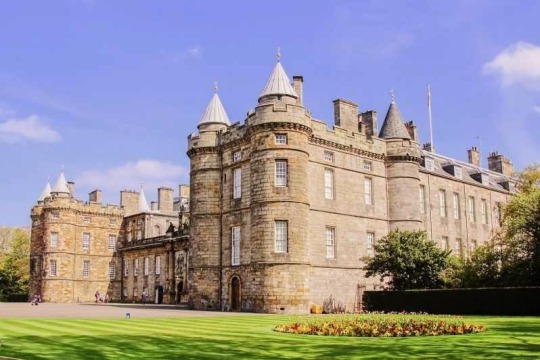






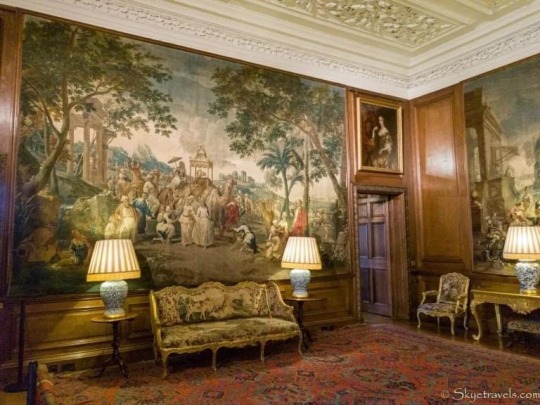


.
• 👑🇬🇧🏴🌷🏰 🤍🖤 🕊️ Queen Elizabeth II's coffin expected today at Holyrood Castle in Edinburgh, Scotland
Queen Elizabeth II died on Thursday 8 September at Balmoral Castle in Scotland at the age of 96 after more than 70 years of reign. Her son was officially proclaimed king by the Council of Accession, under the name of Charles III. On Sunday, the Queen's coffin is expected in Edinburgh before she returns to London for her state funeral on 19 September.
The Queen's coffin has been kept at Balmoral, and will be draped with the Royal Scottish Standard and a crown, since her death on Thursday at the age of 96. After being carried to the hearse by six gamekeepers from the Balmoral estate, the procession will head to the nearby village of Ballater, where it will normally arrive at around 9.15am and where representatives of Aberdeenshire County will pay their respects.
Elizabeth II's remains will then be taken at around 10am to Aberdeen, Scotland's third largest city and a major centre of the oil industry, famous for its grey granite buildings. After another tribute by the local authorities, a public viewing of the coffin will take place in the city's historic park.
The procession will then arrive in Dundee, Scotland's fourth largest city on the east coast, at around 1.15pm. City officials will then bid him farewell.
After a six-hour journey, the Queen's coffin is due to arrive at the Palace of Holyroodhouse at 3pm.
The palace in Edinburgh is the official residence of the monarch in Scotland. Scotland's First Minister Nicola Sturgeon and party leaders will gather in Parliament to watch the coffin pass.
On Monday, a procession will take place along the Royal Mile, the main avenue of the old city, to St. Giles Cathedral where it will lie in state for 24 hours after a church service.
On Tuesday evening, the Queen's coffin will be flown to London.
• The Palace of Holyroodhouse is the official residence of the Monarchy in Scotland.
The Palace of Holyrood is located in Edinburgh, Scotland, at the bottom of the Royal Mile, the main thoroughfare linking Holyrood Palace to Edinburgh Castle.
It was originally a monastery founded by the King of Scotland, David I in 1128. It has served as the principal residence of Scottish kings and queens since the 15th century and of Queen Elizabeth II on her official visits to Scotland.
The term Palace of Holyrood, or simply Hollyrood, is sometimes used to refer to the Scottish Parliament.
British monarchs have always spent at least one week a year at the Palace. Queen Elizabeth II always used it when visiting Scotland on state business.
The role of the Palace has increased since the opening of the Scottish Parliament in 1999, and multiple members of the Royal Family, including Charles III, King of England, or Princess Anne, regularly stay there. It has been suggested that a member of the Royal Family should be hosted full-time at the Palace to represent the Queen (it was hoped that this would be Princess Anne, who has strong links with Scotland).
Queen Elizabeth II met the First Minister of Scotland at Holyrood.
During the UK Presidency of the European Union, a European Council meeting was held there.
The Palace is open to the public when the Queen or a member of the Royal Family is not in residence.
The Scottish Parliament is located across the road from the Palace.
0 notes
Photo








Sorry Katrina, I need a moment...😭
#adventures in avonlea#resident representative nicola#ac wolfgang#acnh blogging#acnh#animal crossing#new horizons#animal crossing new horizons#acnl#hhd#animal crossing new leaf#fall update#amiibo update#ac katrina#acnh update#nintendo#my post
4K notes
·
View notes
Text
For centuries, the Indigenous cultures of present-day Mexico manufactured a brilliant red colorant called "prickly pear blood."
Nocheztli was the name the Mexica (Aztecs) gave this red colorant in their language Nahuatl. That is because in Nahuatl, the cacti were called nopalli and nochpalli, and their fruits were called nochtlí. Thus nocheztlí means blood (eztli) of the cactus (nochtlí,) or "prickly pear blood."
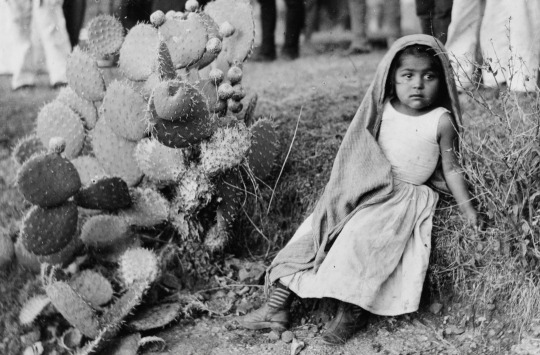
The colorant was actually made, however, from a parasitic insect of the prickly pear cactus, rather than the red prickly pear itself. The vivid carmine red color obtained from this insect evoked the image of blood and the juice of the red fruit.
The insect from which the dye is obtained is popularly called cochineal grana. Its scientific name is Dactylopius coccus . In Nahuatl it was called nocheztli which means "nopal blood" and in Mixtec ndukun which means "blood insect".
Both the insect and the colorant are known as cochineal.
Each pre-Hispanic indigenous culture had a different name for the insect. This ethnolinguistic element indicates the knowledge and early use of coloring by different ethnic groups before the arrival of the Spanish.

The colorant made from the cochineal insect was an astonishingly vivid red. Red was an important color for Mesoamerican cultures as it signified blood, and therefore life.
Indigenous peoples had many uses for it including as a medicine, a cosmetic, a dye for textiles, and a paint for hand-drawn manuscripts.
Mesoamerican manuscripts are important because they give insight into the people represented on them, as well as aspects of their culture. These colorful manuscripts also shed light on the expertise of the Indigenous craftspeople that made them.
The Library of Congress has three significant 16th-century Mesoamerican manuscripts that were all painted with carmine red: the Huexotzinco Codex, the Oztoticpac Lands Map, and the Codex Quetzalecatzin.
But what do we know about cochineal?
Cultivation of Cochineal

Cochineal was primarily cultivated by individuals from cactus plots found on their lands. The production of cochineal was time-consuming and involved several steps.
First the cacti were planted and allowed to grow for up to three years in order to host the insects. After the cacti reached the appropriate size, the Indigenous farmer attached nests containing female insects to the cacti. For 90 to 120 days cochineal insects were allowed to infest the host cacti. After this period of infestation, harvesting involved removing the insects from the cacti by hand with the aid of a pointed stick or a brush. Harvesting domesticated cochineal occurred two or three times per year.
Interestingly, only female insects were harvested because the component responsible for the red dye is solely carried by wingless females. The female of this species, whose life cycle is three months, is the one that contains carminic acid, a substance that is synthesized as a dye. The insect uses this substance as a defense mechanism against predators such as ants. For its part, the male does not require this defense since its vital cycle is brief, it is reduced to a week in which it fulfills the reproductive function and then dies.
A glimpse into cochineal cultivation is provided by the French botanist Nicolas-Joseph Thiéry De Menonville who published an account of his travels in 1777 to Oaxaca to obtain, albeit illegally, the insect for France.
"On arriving at Galiatitlan, I saw a garden full of nopals, and had no doubt I should there find the precious insect I was so desirous to examine. I therefore leapt from my horse, under pretense of altering my stirrup leathers, entered the grounds of the Indian proprietor, began a conversation with him, and enquired to what use he put those plants? He answered, “to cultivate la grana.” I seemed astonished, and begged to see the cochineal; but my surprise was real when he brought it to me, for instead of the red insect I expected, there appeared one covered with a white powder. I was tormented with the doubts I entertained, and to resolve them bethought me of crushing one on white paper; and what was the result? It yielded the truly royal purple hue.”
Grana is the Spanish term for cochineal that translates as "grain," possibly because the dried cochineal insect look like grains or seeds.
What then do we know about how the brilliant carmine colorant was made from the cochineal insect?
Cochineal Colorant Preparation
Sixteenth-century sources provide eyewitness accounts of the production of Indigenous Mexican artist materials. One of the most important sources is the Florentine Codex, or The General History of the Things of New Spain, compiled by Franciscan Friar Bernardino de Sahagún. Twelve books describe the culture and peoples of central Mexico, with detailed descriptions in Spanish and Nahuatl, as well as illustrations of artists materials like cochineal.

After harvesting, the insects were then prepared for processing into a colorant. The first part of the process involved killing the cochineal insects. This was accomplished by drying in the sun, heating in ovens or on hot plates, boiling, or steaming. Regardless of the method employed, the end result of this process was dried insects.
To make a red dye or paint, the dried silver cochineal "grains" are ground into a powder that is then boiled in water. Since the cochineal is an organic colorant, its coloring agent carminic acid must be stabilized with the addition of a mordant, a metallic salt. Powdered alum (potassium aluminum sulfate) was a mordant commonly used by Mesoamerican craftspeople.
Cochineal is sensitive to changes in pH, and as such, its color can vary. Cochineal colorants can range from orange when an acid, like vinegar, is added to the recipe to purple when a base, like ammonia, is added.
The primary uses for cochineal were as a dye for textiles and as a paint. To make a paint, the cochineal insects were soaked in water, ground into a paste with alum, and formed into tablets that were allowed dry.
Tablets of cochineal paint, as well as other paints and artist materials, were made available to artisans in markets throughout Mexico. It is likely that Indigenous scribes painted the red areas on manuscripts with cochineal tablets obtained from these markets.
A large variety of items were sold in Mesoamerican markets including food, raw materials, and artist pigments. The largest market was in Tlatelolco, a neighborhood in present-day Mexico City. Descriptions of the Tlatelolco market were published by Spanish conquistadors Hernán Cortés and Bernal Díaz who were astounded by its large size and the variety of items sold there.
Markets remain an important cultural tradition in Mexico to this day.
Mesoamerican Manuscripts at the Library of Congress
The Codex Quetzalecatzin resides in the Geography and Map Division. Created circa 1593, it is a genealogy map showing the ancestral lands of Lord-11 Quetzalecatzin and his descendants, the de Leon family, between the years 1480 and 1593. It is also known as the Mapa de Ecatepec-Huitziltepec because the de Leon holdings ranged from Ecatepec (near Mexico City) to the north, to Huitziltepec in Oaxaca to the south, with southern Puebla in between.
An Indigenous scribe, or scribes, likely created the codex because it is drawn in a mostly Indigenous artistic style with pictographs that convey information relating to space and time, and toponyms (place-glyphs) relating to specific locations.
Codex Quetzalecatzin
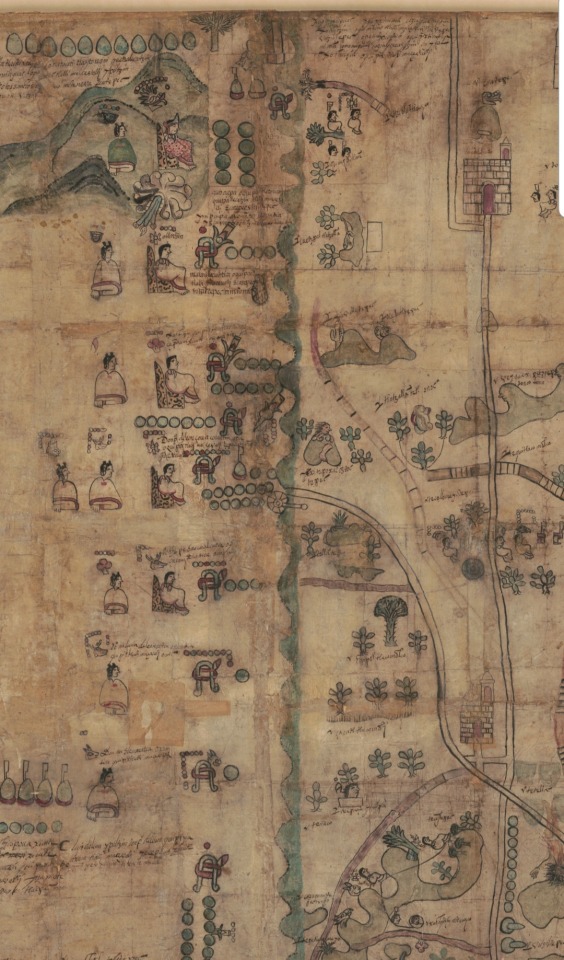
Brilliant carmine red was liberally painted all over the Codex Quetzalecatzin.
The color red is prominently used on the garments of the Indigenous elites. A rich red decorates the borders of the noble women's blouses and skirts and the cloaks of the noble men. Not surprisingly, Lord-11 Quetzalecatzin has the most splendid garments of all with his richly patterned red cloak and headdress.
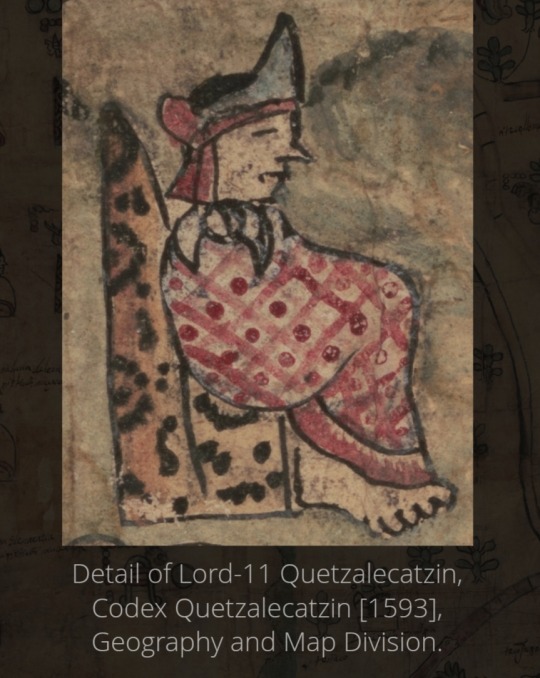
It is not surprising that red paint appears on the codex in many areas, since Puebla and Oaxaca were primary regions of cochineal cultivation during the 16th century. As nopal cacti are prominent features on the codex, it is possible that the de Leon estate produced cochineal.
The Oztoticpac Lands Map, also part of the Geography and Map Division collections, was created around 1540. It concerns the litigation of the estate of the Texcoco lords after one of their members, Don Carlos Ometochtli, was executed for idolatry. Texcoco, a neighbor to Mexico City, was a partner to the Mexica (Aztecs.) The map depicts the Palace of Oztoticpac, land plots of villagers.
Oztoticpac Lands Map
Color was sparsely used on the map, and has faded over the years. Purplish-red lines and Indigenous counting numerals (bars and dots) were used to denote the borders and size of lands owned by the Texcoco nobility.

The Huexotzinco Codex is part of the Harkness Collection in the Manuscript Division. It is one of the earliest Mesoamerican manuscripts from the early colonial era of Mexico. As such, it is a thoroughly Indigenous manuscript as its story is told through pictographs showing the types of tribute items and the Indigenous counting systems.
The Huexotzinco Codex was created in 1531 for the legal case that conquistador Hernán Cortés brought against three members of the first Spanish colonial government in Mexico. The case accused the three government officials of stealing from Cortés by demanding excessive tribute from the people of Huexotzinco when he was in Spain. After the Spanish invasion, Cortés considered the land, natural resources, and the people of Huexotzinco to be his property because the Huexotzincas allied themselves with him during the war against the Mexica. Included in the court proceedings are eight Indigenous paintings submitted as evidence that depict the tribute handed over to the officials.
The eight paintings were produced by Indigenous scribes with Indigenous materials. While seven of the paintings are painted with red, vivid carmine red features prominently on two of them.
Huexotzinco, in the Mexican state of Puebla, was a major producer of cochineal in the 16th century.
Huexotzinco Codex
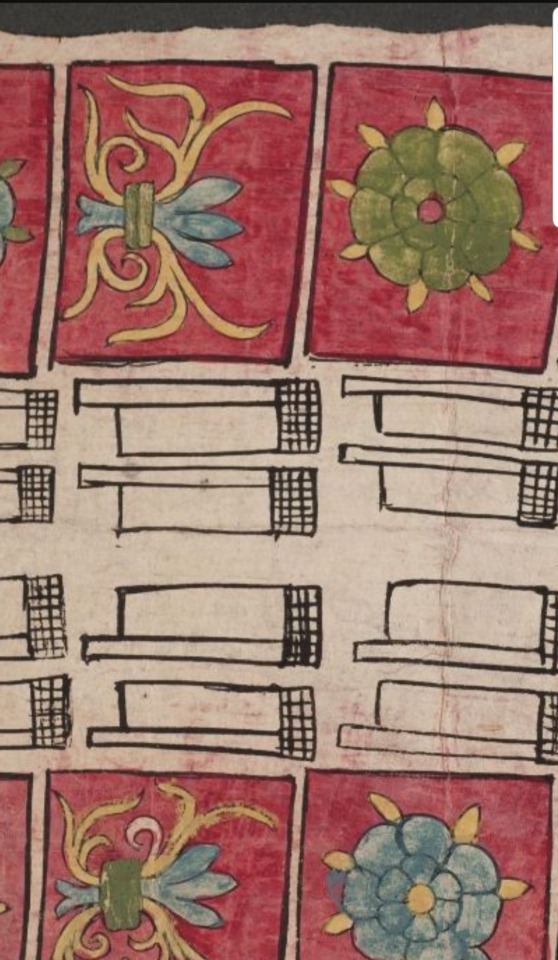
Painting III shows twenty cotton cloths, each richly decorated with an Indigenous calendrical pictograph (Rabbit, Reed, or Flower) representing the count of years or days. A brilliant red background offsets the pictographs. Notably red was used as the background on all of the twenty cloths and was also the most-used colorant.


Colorful, ornamented clothing of cotton and rabbit fur were reserved for the elites of Mesoamerican societies. Thus the carmine red textiles prominently featured on two codex paintings provide insight into the Huexotzinco community as well as the artisans working there.
The three Library of Congress Mesoamerican manuscripts (the Codex Quetzalecatzin, the Oztoticpac Lands Map, and the Huexotzinco Codex) have a shared history. They were created during the first century of the newly formed Spanish colony of Mexico.
Another shared aspect found on all three manuscripts is the use of carmine red paint to illuminate features that were important and specific to the people depicted on them, and to the scribes who painted them.
While visually the reds on the three Library of Congress manuscripts appear to be cochineal, to date material analysis has only confirmed the red on the Huextzinco Codex paintings to be cochineal. Hopefully future scientific analysis will also identify the reds of the Codex Quetzlecatzin and the Oztoticpac Lands Map.
While Spain profited from the production and export of cochineal, credit must be given to the Indigenous Mesoamerican peoples who developed this stunning red, this "prickly pear blood," and gave it to the world.
Once discovered by Spaniards, cochineal became one of the most valuable commodities in Europe. In 1758 alone, Oaxaca exported more than 1.5 million Spanish pounds of it for various uses, including the dying of fabrics for red uniforms worn by British soldiers. It was the most exported from New Spain during the 16th century, after gold and silver.
For centuries Europe sought an intense red that would last over time in textiles such as wool and silk. They had not found a dye with these characteristics until the discovery of cochineal. It was so prized, Spain kept secret that it came from a bug instead of a plant.
The Italian dyers of the 16th century, based in Venice and Florence, were the main buyers of dyes.
Later, in later centuries, this changed and it was the French, the Dutch and later the English who bought the scarlet, both in formal and informal trade through smuggling.
Apart from the textile industry, which is where it had its most widespread use, famous painters such as Rubens, Velázquez and El Greco, among others, also used pigments based on the cochineal grana to add unique colors in their works.
Museum conservation and restoration laboratories in different parts of the world have confirmed the presence of the dye bug in many important works.
The cochineal cochineal from New Spain produced a "boom" in European markets , says Huémac Escalona. It was the second good that generated the most profits for the people involved in its trade, both Spanish and Indian.
The Spanish crown retained the monopoly of this product throughout the colonial period; For this, it kept the secret of its nature and production, preventing the live insect from leaving New Spain. When the Spanish referred to the large cochineal they always used terms that referred to agriculture, so that competitors from other nations believed that it was a vegetable product, a fruit of a plant or a seed.
Today it can also be found as a natural food coloring.
Production of dye in Oaxaca
In the 16th century and the first part of the 17th century, the most intense production of cochineal was located in the Tlaxcala and Puebla areas. Oaxaca was the cradle of domestication of the large cochineal; it also produced in those years but not so intensely. It was not until the second half of the seventeenth century when its production increased, until it produced 99 percent of the scarlet that was exported to the entire world in the eighteenth century.
The relationship between indigenous producers and Spanish merchants around the grana was not without tensions and conflicts, despite this, the wealth it generated allowed that relationship to last over time.
The historian recalls that the indigenous communities accepted to produce the cochineal because it allowed them to have their own social organization and allowed them to have money for their festivals and to pay taxes. Although these were impositions of the colonial regime, these burdens were assumed in such a way as to allow them to have an organizational structure according to their traditions.
The rearing of the insect was an economic activity in which the whole family participated and could be combined with other tasks. The production and trade of grana articulated the economy of various regions of Oaxaca. There were towns that specialized in grana, others combined its production with the manufacture of blankets or the cultivation of corn and wheat. While others were dedicated to making the various containers where the dye was transported.
Most of the indigenous peoples, for their part, became producers of the dye because it meant a more or less secure way of obtaining resources to cover their community expenses and cover tax burdens. This was not exempt from the enrichment of sectors of its population. However, it was not the norm but rather the exception.
Grana connected the economy of societies so different and so far away : Indigenous peoples from the Oaxacan regions with European, African and Asian societies. For the Oaxacan indigenous people, the scarlet was the product that gave them benefits but also caused them discomfort. The constant international demand for dye led to the adaptation of their collective life, governed by a set of beliefs and traditions of their own, to an intense production system.
The traces of the scarlet in Oaxaca are everywhere: in civil and religious public buildings, in merchants' houses, in textiles, in its archaeological remains, in pre-Hispanic and colonial documents, painted with pigments made from the cochineal or where its production and trade were registered. It shows the importance that the precious dyeing insect known as grana cochineal had for the history of Oaxaca and Mexico.
A red color, really Mexican?
In recent years, there has been a debate about the American zone of origin of the dye . A group of scholars assured that the cochineal was domesticated in South America, in the Andean area, due to the discovery of textiles dyed with this dye in various archaeological sites and whose dating dates back to the first centuries after Christ.
Other specialists affirmed that it was in Mesoamerica, specifically in Oaxaca, where the first domestication of the insect was carried out together with the nopal. It is believed that it passed from Mesoamerica to Central America and from there to South America through the cabotage trade.
Recently, a scientific study was carried out that analyzed the mitochondrial DNA of the cochineal cochineal samples from Oaxaca and Peru. The results showed that the genetic variety from Oaxaca is older and more diverse. This confirms that the domesticated dyeing insect is native to the Mesoamerican region corresponding to the current state of Oaxaca, in southern Mexico.
Sources: (×) (×) (×)
#indigenous#mexico#aztec#france#Nicolas-Joseph Thiéry De Menonville#animal#insect#spain#europe#hernan cortes#🇲🇽#italy#dutch#new spain#history#mexican history#oaxaca#puebla#oaxaca mexico#puebla mexico#long post#asia#africa#south america#central america#latin america#peru#nahuatl
102 notes
·
View notes
Link
The Tatmadaw generals’ digital strategy was a key part of their coup. On Monday, the military government made mobile internet access intermittent. On Wednesday, the government blocked Facebook and its products (including Whatsapp and Instagram) to internet users on Myanmar-based telecoms networks. On Friday, Myanmar-based users could not access Twitter. When in-person protests raged over the weekend in Yangon, users found themselves unable to use the internet at all. The use of digital media to spread propaganda as well as internet shutdowns are now important tools of authoritarian ruling and take-over strategies. These same tools are used for surveillance and new extensions of the state into private lives. From Manila to Hanoi, governments use emerging technologies to instil fear in citizens and close down public spaces of discourse. Southeast Asian authoritarian regimes also increasingly govern through the internet, making social media a new part of civil service and a site of resistance (see Simpeng and Tapsell, 2021 for a regional view).
The year preceding the 2018 election in Cambodia has been widely criticised by human rights advocates as representing a rapid pivot towards authoritarianism after twenty-five years of democratisation efforts. Like in Myanmar, internet penetration rates have soared over the past decade and the dominance of Facebook has given rise to the trope “Facebook is the internet” as citizens often confuse Facebook for the internet in surveys and in interviews. In Cambodia, during the lead-up to 2013 national election, the increased popularity of Facebook compromised the power of the state across the country. Social media likes and lurking were tactics used by historically disenfranchised populations, including the rural and urban poor, to participate in politics and loosen the information control of the ruling party (see Vong & Hok, 2018 and Beban et al., 2019). In response, from 2017 onwards, the government took steps to take back control of information at the national level through the regulation and monitoring of social media including the arrest of people for Facebook posts critical of the government. These changes, along with greater censorship of the traditional media sector, have led the Cambodian Center for Independent Media to call 2017 the year that “Cambodia’s facade of media freedom collapsed.”
With a team of researchers, I conducted a qualitative research study in 2018 that examined how village-level officials in rural Cambodia (who are relatively new internet users) utilize Facebook to supplement and extend long-standing patterns of information control. We found that they used Facebook Newsfeed and Messenger, exclusively on smartphones, to promote local government activities, report to the central government, and monitor local affairs. This monitoring has led to widespread “chilling effects,” a phenomenon that occurs when political activists and citizens stop using the internet for dissent due to intimidation. This social media withdrawal often emerges more from the lingering psychological effects of historical violence than the sophistication of technological tactics.
How can we use this research to better understand the dynamics of networked authoritarianism in Myanmar and across the region? With the caveat that the enactments of media shutdowns are playing out specifically in each country, this research does point to two directions of necessary further research into what is currently happening in Southeast Asian digital governance, including in Myanmar:
Firstly, we need to look outside of urban centres to get a more thorough understanding of digital governing strategies and resistance. We have seen encouraging reports of resistance from Yangon, including widespread VPN use, banging pots and pans on balconies and medical professionals refusing to work. Unfortunately, as we have seen in Cambodia, these strategies of resistance often are contained in central commercial areas and among intellectuals and elites. Rural residents, some of whom are in active war zones in Myanmar, often have more recent experience of violence. They also often have less technical literacy. This makes digital forms of resistance more mystifying and frightening, and thus chilling strategies more effective.
Secondly, we need more research into how a robust regulatory framework in the US could address the ways that authoritarian regimes are co-opting US-based corporate platforms. We also need more research into Southeast Asian-based digital innovations that are more resilient against regime take-over. The contemporary political economy of platforms in Southeast Asia is deeply flawed and needs reform. In both Cambodia and Myanmar, one corporate platform based in the US holds a monopoly over a large majority of all internet business. In Cambodia, Facebook is the backbone for the authoritarian regime. Since the passage of new monitoring laws, average internet users are deprived of a public commons for discursive dialogue on the internet. In Myanmar, the government has just unilaterally closed down access to this corporate platform. As users are stripped of Facebook, they are also losing effective access to the internet. The growing concern with the unchecked power of big tech in the US and the EU has led to regulation in domains like privacy (the California Consumer Privacy Act and General Data Protection Regulation) and antitrust (pending cases against Facebook in the US and against Amazon in the EU). These laws have not yet considered the accountability of major platforms for the safety of global users.
The ways that authoritarian regimes are using digital tools and the internet to promote their own agendas, perform surveillance on marginalized groups, and chill oppositional speech are major challenges for the Southeast Asian region. More research needs to be done that gets past the headlines of resistance to understand the dynamics and consequences for the majority of internet users. The nuance that new research would provide might give Southeast Asian-based based companies or civil society groups more information on how to build safer new tools and infrastructures for accessing the internet. Research and corresponding public scholarship into the detrimental effects of corporate monopolies and surveillance both inside and outside of the US might also sway public opinion towards regulation oriented towards the protection of both domestic and global internet users.
In recent research, my co-authors and I explore the relationship between technology and intimidation and describe the enactment of chilling effects in the paper “Networked Authoritarianism at the Edge: The Digital and Political Transitions of Cambodian Village Officials,” accepted and forthcoming in the journal Computer Supported Cooperative Work (Margaret Jack, Sopheak Chann, Steven Jackson, Nicola Dell). We reflect on these global trends through a historically-informed case study of Cambodia.
48 notes
·
View notes
Photo


(Pic 1: the size of Andromeda’s halo if it was visible to the naked eye.)
(Pic 2: Illustration of the extent of the halo and the quasars used to probe it. NASA, ESA, and E. Wheatley (STScI)
Hubble Investigates The Enormous Halo Of The Andromeda Galaxy
Galaxies are surrounded by a spherical halo where diffuse hot gas, dark matter, and a few stars reside. The Hubble Space Telescope has now studied the halo of Andromeda, the closest galaxy to the Milky Way of a similar size. If you think the Andromeda galaxy is big, its halo will blow you away.
The halo stretches over 1 million light-years from the galaxy, which in itself is 220,000 light-years across. The study, published in The Astrophysical Journal, highlights how the halo is not a simple structure but actually complex due to the internal processes of the galaxy.
“We find the inner shell that extends to about a half million light-years is far more complex and dynamic,” study leader Nicolas Lehner, from the University of Notre Dame, said in a statement. “The outer shell is smoother and hotter. This difference is a likely result from the impact of supernova activity in the galaxy’s disk more directly affecting the inner halo.”
The team detected the presence of heavy elements in the gaseous halo. This is a clear sign of where the material came from. Heavy elements are produced in stars and distributed across space when stars reach the end of thier lives, especially when they go supernova.
These incredible observations were possible thanks to Project AMIGA (Absorption Map of Ionized Gas in Andromeda), which observed 46 quasars (extremely bright galaxies) in the line of sight of where the halo was expected to be. These were used as “backlights” to illuminate the diffused halo so that it could be studied by Hubble.
“Previously, there was very little information – only six quasars – within 1 million light-years of the galaxy. This new program provides much more information on this inner region of Andromeda’s halo,” explained co-investigator J. Christopher Howk, also of Notre Dame. “Probing gas within this radius is important, as it represents something of a gravitational sphere of influence for Andromeda.”
We do not have instruments to conduct these kind of studies of other major galaxies, so AMIGA serves as a proxy for what might go on around other spiral galaxies in the cosmos.
“Understanding the huge halos of gas surrounding galaxies is immensely important,” explained co-investigator Samantha Berek of Yale University. “This reservoir of gas contains fuel for future star formation within the galaxy, as well as outflows from events such as supernovae. It’s full of clues regarding the past and future evolution of the galaxy, and we’re finally able to study it in great detail in our closest galactic neighbor.”
https://www.iflscience.com/space/hubble-investigates-the-enormous-halo-of-the-andromeda-galaxy/
52 notes
·
View notes
Text
properly introducing my main fanservants!!!
LOTS OF PHOTOS/ART AND SUCH UNDER THE CUT BUT LIKE,,,, THIS IS JUST. A QUICK INTRODUCTION. TO MY PRIMARY SERVANT BASTARD CHILDREN- (in order of appearance; Sebastian Moran, John Watson, Enola Holmes, Columbia, Thomas Edison (True), Nicolas Flamel, Captain Stormalong, Edgar Allan Poe)
Feel free to hop in my ask box if you wanna talk about them or have any questions!!! Thank you for reading ily-
Colonel Sebastian Moran (Assassin)

My primary servant OC by far! Professor James Moriarty’s chief-of-staff and right hand man- the second most dangerous man in London, after the Napoleon of Crime himself. Nicknamed ‘Basher’ or ‘Tiger Jack’, among others..
Moran is- or was- the most skilled marksman in the British Army, before he was dishonorably discharged. There are only a handful of men on the face of the continent able to shoot as well as he. As well as being an unnaturally skilled shot, he is a devoted sportsman and big-game hunter, and has notoriously tangled with tigers by himself in India- a predator that rather aptly describes the man himself. He authored two books, and his feats are still legendary in India, where his record 'bag of tigers' still goes unmatched. Although his outwards appearance was that of a respectable London gentleman and honorable military veteran, he gained a reputation in the evil underworld and was recruited by James Moriarty, serving as his 'chief of staff' of his criminal empire as well as his personal assassin for jobs that required his peculiar skill with a rifle.
The man is, as one Chaldean staff member puts it, a 'stone-cold badass'. He has a nerve of iron, and is vehemently loyal to both Professor Moriarty and his Master. He lives for danger, and the thrill that comes with 'kill or be killed' situations. Moran is also extremely easy and obvious to read- smiling 'like an idiot' when happy, and 'frowning like thunder' when angry. He does rather enjoy killing people, and is overall a man of few morals (although still having more than the Professor)- which, paired together, is what led to his leave from the military as he's practically a walking example of the 'Colonel Kilgore' trope. The more challenging the kill, the more enjoyment he gets out of it. As a strange upside, Moran has no illusions of how he's a right bastard.
"Ask anyone who knew me in the army, and you'll hear the same things about Basher: tiger in the field, bounder in the mess; a good man to have your back, but a bad man to show your back to; trust him with a fight, but not your sister, your wallet, or a deck of cards."

His Noble Phantasm, which represents his unmatched skill with a rifle, is called BEBR DER KHANH KHALI - Persian for ‘the tiger in the empty house’.
The bullet shot is, unlike others, a specially-made expanding revolver bullet which makes Moran unable to be likely linked to the kill. Much like a ghost or a tiger stalking its prey, he is completely silent in his attack, and the target can never see him coming before they're already dead- and just as quickly he is gone, seemingly disappearing into thin air without a trace.
No matter the conditions or distance, as long as Moran can see his target in some way- whether by the naked eye or through his scope, or perhaps in some other manner- his shot is guaranteed to hit its mark with deadly accuracy.
Also, if you find him not wearing his coat, it’s probably because he gave it to Jack. He loves knife child. They deserve proper clothes.

(source: amon-sheep on twitter)

(source: manalmmune on twitter)
[[LINK TO HIS CHAPTER IN MY FANSERVANT FIC]]
--
Doctor John Watson (Caster)

The famed Boswell and best friend of the great detective himself. Aman who is most like his traditional origin, as opposed to the heavyset comedic figure modern media tends to make him out to be- aka the Watson that is described by Doyle as a former rugby player, an army man, and popular among the fairer sex due to his handsomeness, intelligence, and charm.
He quickly becomes a proper ‘fatherly’ figure in Chaldea and especially to Master, due to his big dad energies, despite never having the chance to be a father in his life. Chaldea also appreciates finally having a proper doctor that isn’t a Berserker or... whatever’s going on with Ascelpius. Watson is Holmes’s life compass, the loyal companion always by his side who balances the detective out.
Although he’s a caster, he also wields his trusty wartime revolver, and is curious in that, unlike most casters, he has one offensive Noble Phantasm- it’s his secondary, and his primary ‘Conductor of Light’ crystallizes Watson's role as a 'whetstone' for Sherlock Holmes's mind and unmatched stimulator of his famous flatmate's genius. As Holmes himself summarizes, “It may be that you are not yourself luminous, but that you are a conductor of light. Some people without possessing genius have a remarkable power of stimulating it.” This Noble Phantasm is purely supportive, serving to bring out the absolute best in an ally- whether it be manifested in power, magic, or inspiration- and temporarily unlocking a vast wealth of potential that they might not have even known they had. The exact limitations or bounds of it is not known, as it can seemingly extend in purpose as far as Watson or his Master might need it to in a given situation- able to provide buffs, grant moments of unmatched mental clarity or courage, and even unlock hidden abilities and Noble Phantasms if the moment is dire enough. His secondary NP is one he rarely uses, and hates to do so, because of the bad memories it dredges up- called ‘The Reichenbach Solution’, it creates a reality marble recreation of Reichenbach, with the roaring waters and a single shot from Watson himself sending the enemy tumbling off the falls to their demise.
Watson was old friends with Moran in the army, and reconnect during their time in Chaldea (despite Holmes and Moriarty’s protests), and he also joins the ‘author squad’ and spends much time with them. He is a rational man and sturdy as they come, always there when needed; whether it be to patch up wounds, help solve mysteries, or to help Master deal with all the mental trauma from their adventures (because holy shit they need HELP-). Also Also he probably just straight up adopts Mash, he and Holmes are her new gay dads.


(source: gomooink on twitter)
--
Enola Holmes (Ruler)

If Sherlock is the representation of all great detectives, then the teenage Enola Holmes is the representation of all female sleuths. Originally far too weak to be a servant- her source material being extremely modern (Enola Holmes series by Nancy Springer), she contains the essence of the great detectives of the fairer sex, but most importantly of two Divine spirits- Athena and Persephone (not Ma’at, despite what the image says-), both Greek goddesses. Athena is the dominant of the two, and a maternal figure to Enola, while Persephone is content just to sit back and enjoy the ride.
The younger sister of Sherlock and Mycroft Holmes (and sometimes, the mysterious elder sibling Sherrinford), Enola is much like her more famous brother- similar in lanky stature and physical features, including the prominent hawk-like nose. She is plain in appearance but behind bright eyes hides an intelligent, clever mind, albeit a stubborn and hard-headed one. She is a rebel at heart, resisting the efforts of society to shove her into the mold of a perfect subservient Victorian woman. Enola often uses being underestimated due to her sex and age to her advantage, and, like Sherlock, is quite adept at the art of disguise. With her Spirit Origin also containing figures like Nancy Drew and Miss Marple, Enola is a talented private investigator with a knack for seeing things from angles that other’s can’t- like that of a woman.
Also yeah, she gay. Keep scrolling. She would like to hold hands with Mash very much.


(enola w/ her brother mycroft; source, dewa-chan)

(concepts for her ascensions, mostly cemented, again courtesy of dewa-chan who i owe my life to always and forever-)
--
Columbia (Ruler)
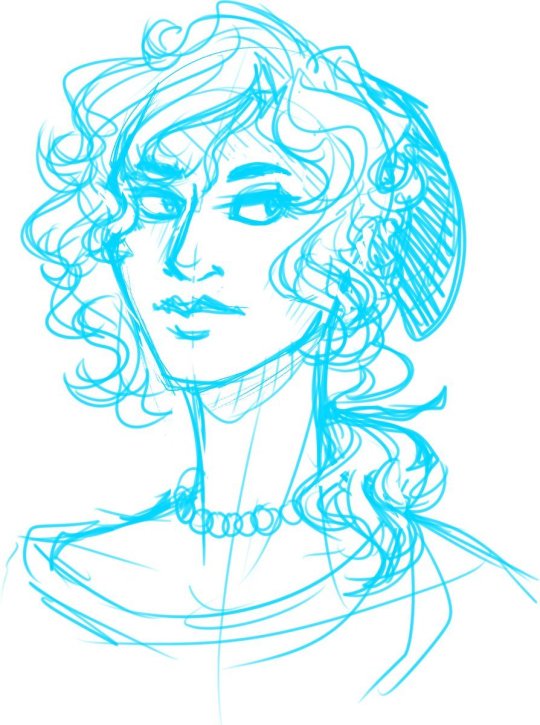
The Divine Servant calling herself Columbia is a complex individual. At face value, she is the personification of the United States of America, often visualized as a goddess; a quasi-mythical figure first written about by the enslaved poet Phillis Wheatley during the Revolutionary War in her work To His Excellency, George Washington. Columbia is, in fact, an amalgamation of two lesser Divine Spirits. One of them is the Roman goddess of liberty, Libertas. The majority of personifications of liberty are merely aspects and appearances of her, including the Statue of Liberty and the unidentified woman in the painting Liberty Leading the People, leading to Libertas having a more powerful- if rather confusing- Spirit Origin compared to most other minor Roman deities. The other is Columbia herself; a goddess first encountered by Chaldea during the odd adventures with Paul Bunyan. She is the symbol of America, and although she is technically a goddess, she is not worshiped- instead existing as an anthropomorphic personification akin to Uncle Sam. She is a goddess crafted by humankind, a manifestation of the thirst for freedom and equality that resides in the heart of man.
However, her existence is still closely intertwined with Libertas, having come from her 'lineage'; Columbia explains that if other personifications of liberty were to manifest, such as Marianne- the French icon of liberty, they would have to have Libertas accompanying their own Spirit Origin to be anything more than a Phantom. Columbia is not only linked to the nation carrying the name America, but to the land itself- in her earliest incarnations she served as a representation of the Americas- both South and North- to those across the Atlantic. She protects all who walk across the great frontier, and all those who have walked it before. Geronimo often voices his hopes that she is the same goddess that brought the first peoples of the yet-unnamed land delicious maize in abundance; Columbia only ever gives a knowing wink, always keeping the answer to herself.
Columbia tries to speak like a newscaster- that is, without an accent- to hide that fact that her true accent as a Servant is the thickest fucking New York brogue you can imagine. AYYYY, SHE’S WALKIN’ ‘EEEEERE!!!!
She has two Noble Phantasms- a support one, her main, called ‘ TORCH OF THE NEW COLOSSUS: THE DREAM OF A NATION ‘, and an offensive albeit rarely used NP called ‘ STRIKE FOR FREEDOM: DO NOT WEEP, FOR WAR IS KIND ‘ that has anti-Country parameters /because it straight up fuckin’ manifests the american military from all across its history-/
Columbia is just... a big country mom. who can grow to the size of the statue of liberty. whoops.
[[LINK TO HER INTRO CHAPTER IN MY FANSERVANT FIC]]
--
Thomas Edison (True) (Caster(?))


BASTARD MAN. BASTARD. This Thomas Edison, though being initially called an Alter, is actually the True manifestation of the ‘Wizard of Menlo Park’ without the influence of so many presidential heroic spirits. To match Tesla, he’s a 5*. I have him as Caster but... that’s still up in the air, tbh.
He will steal your Noble Phantasm and claim it as his own. It’s actually one of his Skills- ‘Intellectual Copyright’. It blocks an enemy's ability to use their Noble Phantasm, sealing it for a length of time, while also buffing Edison in return- the strength of the buff received is proportionate to the strength of the sealed Noble Phantasm. This embodies Edison's habit of taking other people's ideas for his own, and while he often improved upon them, he still claimed them as solely his creations. He can copy the abilities of others and shape them to his own needs, always at the ready with a lawsuit in hand if anyone dare complain!
He is not allowed around Ivan or Ganesha due to his history with elephants and electrocution.
His Noble Phantasm (he may have more than one, he gets VERY shifty when asked) is a manifestation of his most terrible and deadly creation- the electric chair. He can also create a reality marble of a fantastical Menlo Park, a thriving center of innovation and invention, using his Territory Creation.
Did I mention he’s a bastard? God, he’s a bastard. He’s incredibly intelligent BUT HE IS A BASTARD. He’s Evil alignment (arguably, may be Chaotic Netural-). It pains Tesla to admit that he actually likes normal Edison (furry man) much more.
Ask him what he did to Louie Le Prince and he’ll sock you in the jaw and take off running (and also not answer).
--
Nicolas Flamel (Caster)

The Alchemist, the great and immortal Nicolas Flamel himself. He’s a sad old lanky Frenchman DILF dad who misses his wife a lot, and is always ready to throw hands with Merlin and/or Paracelsus. He’s a potential candidate for the Grand Caster class, but is behind Solomon and Merlin in ‘line’. Flamel was a successful French scribe who would gain a reputation as an alchemist after his death in 1418- or at least, his presumed death. He was rumored to have been successful in his creation of the Philosopher's Stone, an artifact with the ability to transmute base metals, and with it was able to create a way to achieve immortality. This Stone was his magnum opus, and he was the first to successfully create it- a fact he makes sure that Paracelsus is aware of at all times.
Also, much like Merlin, he’s not a true Servant. This is THE Nicolas Flamel. But... what happened to Perenelle, his wife? He does not like to talk about it.
He enjoys peace and quiet, educated debate, and reading. Flamel gets on quite well with his fellow Frenchman Dantes, as well as with Waver/El Meloi.
THE DRAGONS OF FLAMEL (Skill): Flamel summons a staff of Cadeceus. Carried by the Greek god Hermes in mythology, it is said "...wake the sleeping and send the awake to sleep. If applied to the dying, their death was gentle; if applied to the dead, they returned to life". In the hands of Flamel, it can stun an enemy or counteract the effects of a stun-inducing skill upon an ally. As well as that, it can channel the effects of its corresponding god-named element mercury, able to dissolve many metals like silver and gold at will. However, like mercury, this skill is extremely volatile and prone to backfiring violently on Flamel if overused.
ELIXER OF LIFE (Skill): The ultimate alchemical creation- the solution, part of Flamel's legend, that granted he and his wife immortality. He keeps a small flask of the elixer on him at all times, and can be used in a pinch to heal all of Flamel's physical wounds, or that of a singular ally. However, it is not enough to grant an ally immortality, nor is it enough to heal multiple mortal wounds. The substance takes exactly one week, given the right materials, for Flamel to remake and refill his flask with some of the elixer.
He has two Noble Phantasms, one being ‘The Stone of the Philosphers’, and the other being ‘The Book of Abra-Melin the Mage’.
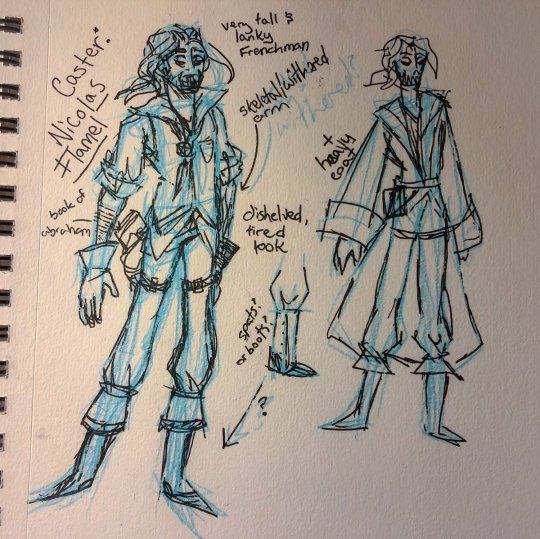
[[LINK TO HIS INTRO CHAPTER IN MY FANSERVANT FIC ALSO THERES A LATER CHAPTER WHERE HE ATTEMPTS TO THROW HANDS W/ PARACELSUS]]
--
Captain Alfred Bulltop Stormalong (Rider)
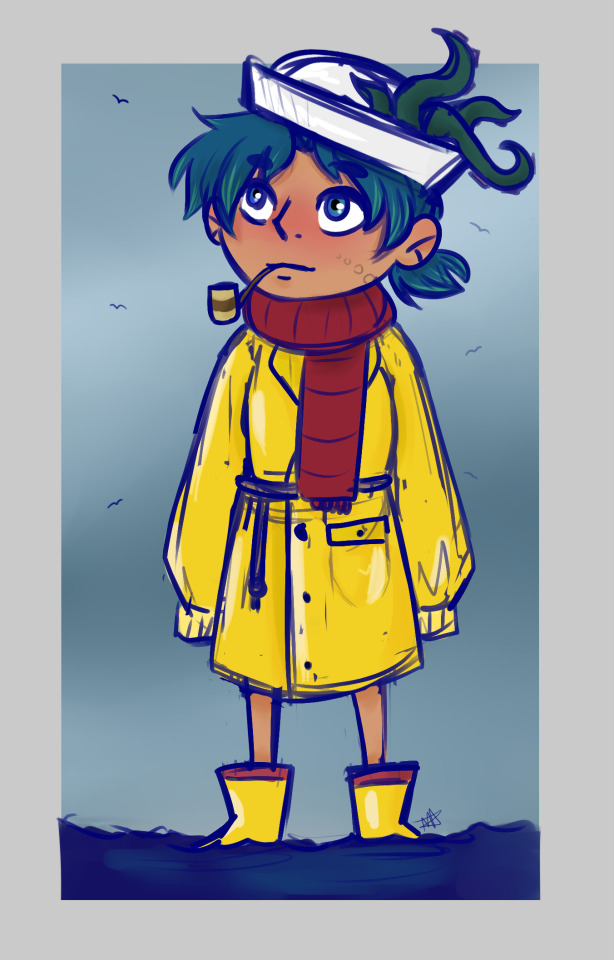
Captain Alfred Bulltop Stormalong is, plainly put, pretty much a nautical version of Paul Bunyan. Like Bunyan, he can change his size at will, growing to huge proportions. His giant ship was said to have hinged masts so as not to catch them on the moon, and had a stable of Arabian horses on board for his crew to get from one end of the ship to the other! Stormalong is said to have had a lifelong rivalry with the fabled Kraken- but unfortunately for the legendary sea beast, it got summoned alongside Stormalong and has begrudgingly taken up residence in his hat in a somewhat smaller form.

His main weapon (not drawn) is a ship's anchor he wields like a flail. His pipe is really just for the aesthetic as he can't use it to smoke, but it does blow bubbles! His Noble Phantasm is The Courser and the Kraken (Massive all-enemy damage + stun).
He’s a good boy who loves boats, the water, and clam chowder.
--
Edgar Allan Poe (Foreigner)
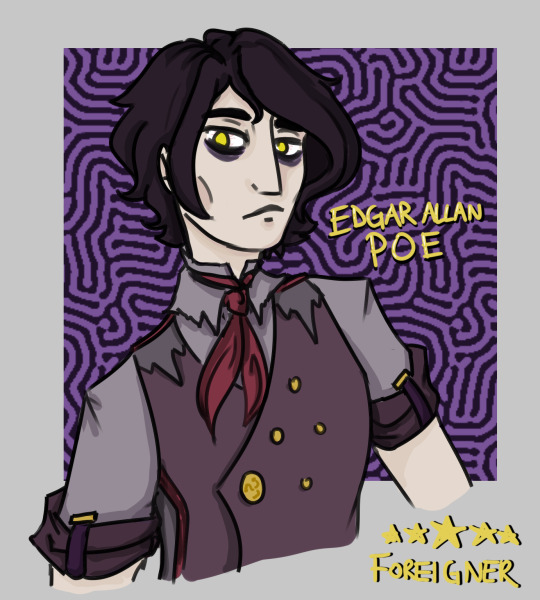
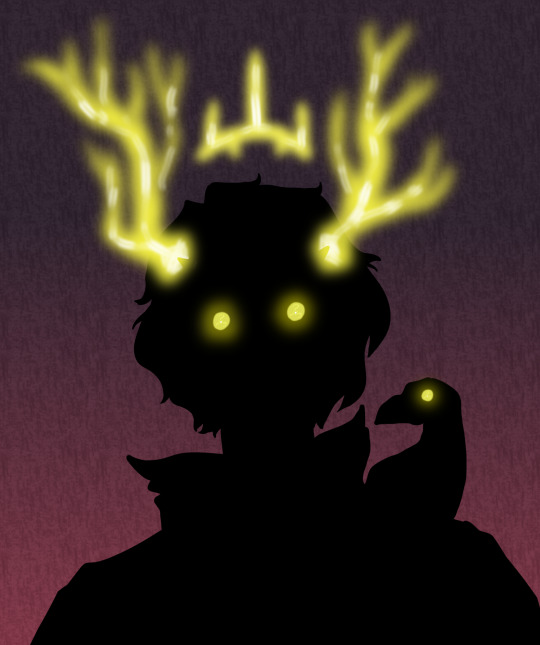
The alcoholic author himself, Edgar Allan Poe is a Foreigner-class servant, being linked with the King in Yellow- Hastur the Unspeakable.
Sometimes you can find him locked in a tiny pitch-black closet with Dantes and Sherlock, all three of them puffing away in utter silence on their tobacco. Hastur most often takes the form of a multi-eyed raven chillin’ on his shoulder, and is capable of speech- if prodded, he will shit-talk the patrons of Poe’s fellow foreigners. He really doesn’t like Cthulhu and Yog, even if Poe has psuedo-adopted Abby, WHOOPS. Hastur, to his credit, is the least malevolent Elder God/patron in Chaldea- though if he is seen chatting with Moriarty by any servants or staff, Master must be alerted immediately.
True to form, he’s very macabre, with a unique dramatic way of speaking much like his writings. He’s unsettling and creepy, but has impeccable manners and likes to chat (he’s very lonely-). He enjoys a good mystery, and is prepared to find Arthur Conan Doyle if he be a heroic spirit and beating the snot out of him for treating Holmes so poorly- Poe was the inventor of the detective fiction genre, after all. Most of skills manifest visually as references to his most famous works. His NP is ‘ A DREAM WITHIN A DREAM : THE CRY OF THE YELLOW RAVEN, NEVERMORE ‘
He doesn’t know what a ‘Hot Topic’ is, but it sounds intriguing!
And no, he doesn’t know what the hell was up with his death either. Weird shit happens in Boston.


#sebastian moran | assassin#john watson | caster#fgo oc#fanservant#fate grand order oc#enola holmes | ruler#captain stormalong | rider#nicolas flamel | caster#columbia | ruler#thomas edison | caster (true)#edgar allan poe | foreigner#servant#fate grand order
71 notes
·
View notes
Photo


Peering inside the birthplaces of planets orbiting the smallest stars Astronomers detect ring structures in the planet forming disks of young, very low-mass stars. Scientists have been finding ring-like structures indicating planet formation in the disks surrounding young Sun-like stars for several years. Astronomers led by Nicolas Kurtovic from the Max Planck Institute for Astronomy in Heidelberg, Germany, have now detected similar signals in disks of young very low-mass stars that are considerably smaller and less massive than their counterparts. Although these stars represent the vast majority of the stellar population, they only host 10% of the known exoplanets to date, including terrestrial and Jupiter-like planets. While theorists have yet to derive a satisfying model that explains the formation of such giant planets inside the rather low-mass disks of the smallest stars, the new results are the beginning of a systematic investigation to solving this mystery. To date, astronomers have found about 4400 planets in more than 3200 planetary systems around stars other than the Sun. These numbers are biased, because only about 10% of the known exoplanets orbit so-called Red Dwarfs, although these stars make up for roughly three-quarters of the stellar population in the Milky Way. Red Dwarfs are the least massive, smallest and coolest stars that exist. They are extremely faint compared to most known planet harbouring stars, making them very hard to capture and investigate. For all the same reasons, astronomers only know little about the processes that form planets in the disks made of gas and dust surrounding them at a young age. To improve our understanding, a team led by Nicolas Kurtovic, a PhD student at the Max Planck Institute for Astronomy (MPIA) in Heidelberg, Germany, has now mapped and analysed six such disks around young very low-mass stars (VLMS) with unprecedented detail. VLMS are stars with masses of less than 20% of that of our Sun. “Despite the tremendous progress in understanding planet formation during recent decades, we don’t know much on how the planets of the most common stars form,” Kurtovic points out. Especially the detection of Jupiter-type planets in orbit around VLMS like GJ 3512 (see section “Related articles”) is puzzling and defies the commonly accepted paradigm of planet formation. Their circumstellar disks, from which the planets emerge, only have comparably small amounts of material, making it difficult to form such massive planets. The researchers used the Atacama Large Millimeter/submillimeter Array (ALMA), currently one of the most powerful radio interferometers. It is jointly operated by the European Southern Observatory (ESO), by the National Radio Astronomy Observatory (NRAO), and by the National Astronomical Observatory of Japan (NAOJ). The astronomers observed the objects at a wavelength of 0.87 millimetres to trace dust and gas at an angular resolution of 0.1 arcseconds. This angle corresponds to the size of a human’s pupil at a distance of around 10 kilometres. Published data complement the investigation. While considering the optical response of the telescope, they modelled the likely correct shape of the disks. Half of the disks Kurtovic and his colleagues investigated show ring-like dust structures that extend between 50 and 90 times the distance between the Sun and Earth (defined as 1 astronomical unit = 1 au). Their arrangements appear similar to the ones of larger disks of more massive young stars like HL Tau, whose images continue to fascinate astronomers. They commonly explain such rings as giant planets accumulating dust and gas while orbiting the central star. “We explored several alternative physical processes to explain the patterns, such as stellar irradiation evaporating the dust. Still, planet interaction remains to be the most plausible explanation also for our VLMS sample”, Kurtovic says. The sizes of the gaps cleared by such planets around VLMS would require planetary masses similar to Saturn. The disks around VLMS indeed contain enough material to feed new-born planets. However, this is not the biggest challenge. Confining the dust quickly enough to build planetary embryos on which the gas accumulates to form planets is even more difficult. Time is of the essence because the dust gradually moves inward and eventually evaporates close to the star. This radial migration is about twice as fast as for the more massive stars, leaving little time for the rocky embryos to grow. “We estimate that the ringed structures we see around the VLMS must have formed within only 200,000 years before the dust would have migrated to the central star”, Dr Paola Pinilla explains. Pinilla leads a research group at MPIA titled “The Genesis of Planets” in which Kurtovic is a member. Once these embryos are present, the gaps they carve while orbiting the star serve as a border that the dust cannot cross. At this stage, the planet can grow steadily by accreting gas and dust. Kurtovic and his colleagues demonstrate that the dust disks are embedded in gas disks four times the size. Initially, they both must have had the same size, which tells us how far the dust had migrated before taking up its current position. In the remaining three of the six disks observed, the dust appears more centrally concentrated to sizes between 20 and 40 au. They lack an apparent structure, which is probably the result of the inadequate angular resolution. “We think that we will see rings even inside the smaller disks once we obtain better-resolved observations”, Kurtovic predicts. “This pilot study was a challenging task because the VLMS disks are small and possess relatively little material, resulting in feeble signals that are very hard to detect,” Pinilla admits. However, the investigation has shown that, with the right instrumentation, astronomers can look into planets’ birthplaces even in the faint disks of VLMS. This ability opens a new door that supports the theorists’ efforts to develop an adequate model of planet formation for even the smallest stars, which live longer than any other type of star. “We still do not know how common planets around Red Dwarf stars are”, Kurtovic concedes. “However, the longevity of Red Dwarf planetary systems is intriguing concerning habitability and hypothetical civilisations”, he adds. In this sense, these faint red stars may be the most interesting ones in the Galaxy. TOP IMAGE....Artistic representation of a planet-forming disk of dust and gas around a very low-mass star (VLMS). The inner dust disk contains a ring structure that indicates the formation of a new planet. The dust disk resides inside a larger gas disk whose thickness increases towards the edge. Image: MPIA graphics department LOWER IMAGE....Observational data and model of the dust disk around the VLMS MHO6. Left: Image of the dust disk. Middle: The disk model with a 20 au wide central hole, which is consistent with a Saturn-mass planet located at a distance of 7 au from the star, accreting disk material. Right: Radial profile of the model (blue) and after convolving it with the telescope’s angular resolution (red). The black symbols represent the data obtained from the measured brightness distribution. The grey bar corresponds to the angular resolution of the observations Image: Kurtovic et al./MPIA
4 notes
·
View notes